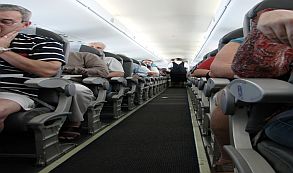The International Air Transport Association (IATA) announced global passenger traffic results for February showing continuing strong demand growth for domestic and international travel. Total revenue passenger kilometers (RPKs) rose 8.6%, compared to the same month last year. Monthly capacity (available seat kilometers or ASKs) increased by 9.6%, and load factor declined 0.7 percentage points to 77.8%.
«In the first two months of 2016, demand for passenger connectivity is off to its strongest start in eight years. However, February was the first month since the middle of 2015 in which capacity growth exceeded demand, which caused the global load factor to decline. It is unclear whether this signals the start of a generalized downward trend in load factor, but it bears watching,» said Tony Tyler, IATA"™s Director General and CEO.
International Passenger Markets
February international passenger demand rose 9.1% compared to February 2015, which was an increase over the 7.3% yearly increase recorded in January. Airlines in all regions recorded growth. Total capacity climbed 9.9%, causing load factor to slip 0.6% percentage points to 76.6%.
"¢ European carriers saw February demand increase by 7.7% compared to a year ago. Traffic has recovered following disruptions in the 2015 fourth quarter related to airline strikes and the shutdown of Transaero in Russia. Capacity climbed 7.8% and load factor dipped 0.1 percentage points to 78.3%.
"¢ Asia-Pacific airline"™ February traffic rose 11.2% compared to the year-ago period. Capacity increased 10.3% and load factor climbed 0.7 percentage points to 78.3%. Comparisons with 2015 are distorted by the timing of the Lunar New Year celebrations, which took place in February this year. Slower economic growth in many of the region"™s economies has been at least partly offset by the 7.3% increase in the number of direct airport connections within the region, which has helped to stimulate passenger demand.
"¢ North American airline"™ traffic climbed 3.6%, which was the slowest among the regions and was exceeded by a capacity expansion of 4.8%. In turn, this caused load factor to fall 0.9 percentage points to 75.9%. US airlines have been focusing on the larger and more robust domestic market, although that market is showing signs of slowing in recent months.
"¢ Middle East carriers had an 11.3% demand increase in February compared to a year ago. This was exceeded, however, by a 16.9% rise in capacity that caused load factor to drop 3.7 percentage points to 73%. Traffic growth has now lagged capacity growth for six consecutive months.
"¢ Latin American airlines saw February traffic jump 10.4% compared to February 2015. Capacity increased by 10.1%, boosting load factor 0.2 percentage points to 79.8%, highest among the regions. Domestic passenger demand remains under pressure from economic difficulties in the region"™s biggest economies, but this seems not to be affecting business-related international travel.
"¢ African airlines posted the strongest demand growth among the regions with February traffic up 12.7% compared to a year ago. The pick-up indicates that carriers here are regaining market share through efforts to rationalize networks and enhance revenue management systems, after several difficult years. It also aligns with a jump in exports from Africa. Capacity rose 13.4%, and load factor slipped 0.4 percentage points to 63.7%.
Domestic Passenger Markets
Domestic travel demand rose 7.9% in February compared to February 2015, which was an increase over growth of 6.9% in January. All markets except Brazil showed growth, with the strongest increases occurring in India, the US and China. Domestic capacity climbed 9.0%, and load factor fell back.0.8 percentage points to 79.7%.
"¢ India led all domestic markets again with a 24.6% year-on-year growth, supported by the strong economic backdrop, as well as notable increases in services. This trend is expected to continue with flight frequencies in 2016 scheduled to increase by 11.5% year-on-year.
"¢ Brazil"™s domestic market decline may be starting to bottom out but the highly uncertain economic and political outlook could pose challenges for airlines in the near-term.
The Bottom Line
«On March 22 we had a grim reminder that transportation"”including aviation"”remains a target for terrorism. The attacks in Brussels were an attack on humanity"”a terrible tragedy"”that was met with resilience. The subway is back in operation. And the airport is working hard to return to normal operations that will reconnect Europe"™s capital with the world. Aviation is a force for good. And we are once again proving that terrorists will never succeed in destroying the fundamental urge of people to travel, explore and learn about the world,» said Tyler.



